How wonderful that Germany has renounced nuclear power. A brave decision that may cost something economically but should regain them the moral authority lost by the Nazis. If the world follows their excellent example we humans might just survive.
Here is an article I wrote in “The Save Rembrandt Campaigner” before the exhibition “Rembrandt and his Workshop” opened at the National Gallery in 1991. From the newspaper reproduction you will not be able to see quite how bad Joudeville was as a painter; so I put a colour reproduction below it.
Article from the Save Rembrandt Campaigner
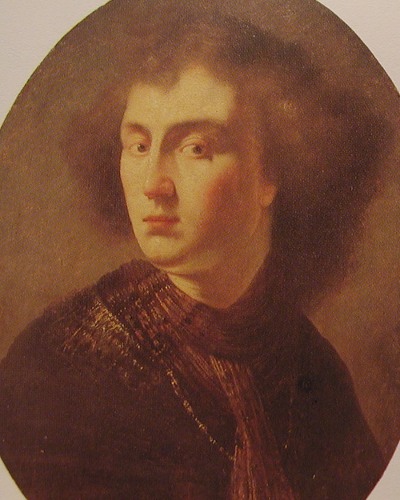
Jouderville's painting
It is not just the fact that the head does not fit on the shoulders, all the geometry of the head is askew. It has a superficial likeness to Rembrandt because Joudeville was his student for a short time in Leiden. When Rembrandt left for Amsterdam Joudeville understood he did not have the makings of a painter and enrolled in the university.
How a man who has spent five years at art school could make such a gross error of judgment beats me. How that same man could go on regaling us with his connoisseurship in his subsequent publications and at the Benboom party, is a positive miracle of self-delusion. After my article Dr. Christopher Brown, then of the National Gallery, obviously agreed with me and Van der Wetering’s great discovery of Joudeville (revealed in volume III of the RRP) was quietly dropped.
Apart from aesthetic considerations, the sheer foolishness of suggesting that the young Rembrandt who went to Amsterdam to make his name would have had the temerity to send in a student to do a commissioned portrait for him should have alerted his colleagues that all was not well.
I was invited to speak about Rembrandt by PINC, a Dutch equivalent of Ted. It was a great experience. One got a mere 20 minutes to say one’s piece. I spent ages trying to cut mine down to that length. I just about managed it but at the last minute I tried to include something about two previous speakers that were relevant to my story. It ate up precious minutes so the rest was too hurried. Fortunately, I had a second chance which turned out very much better (see “Triumph”)
I have had a most fruitful time at exhibitions here in Amsterdam, Leiden and the Hague. I also had a good talk with Dr. C.Vogelaar who is in charge of Lakenhall at Leiden and the curator of The Lucas van Leiden’s shows there and at The Rembrandt House. The shows were a great treat, I saw a clear line of descent even from Lucas’ teacher, to Rembrandt. Rembrandt quite clearly doted on LvL. Not only did he pay a very high price for his prints initially. He re-bought them after his bankruptcy and hung on to them till he was forced to be porn them in1668.
Lucas was not a great painter but the syntax of his drawings and prints was a very strong springboard from which Rembrandt took off. In my analysis of the syntax in my DVD I use Holbein and Roman portraits as the springboard but Lucas was a hero in his own town. I will write a little piece about it here when I receive the necessary photos from Dr.Vogelaar.
The Rembrandt House Museum has done a wonderful job of restoring the house to something very like it must have been (nearly new) in Rembrandt’s time. It now gives a real sense of what it once was. The only thing missing is the multitude of old clothes, cloths and props, which I am assured will be present, if not in multitudes, when the present exhibition of Rembrandt and Lucas van Leiden finishes. They, of course are very strong corroboration of my view of Rembrandt.
ps. The baskets full of life casts of hands and a head painted by Rembrandt himself was also missing!
I have one horror to report of my Dutch visit: the same modern varnish that I was worried about in the Bronzino show is being used everywhere and on the Rembrandt’s in the Mauritzhuis it is a disaster. If you can imagine a shiny surface on a dark and highly textured painting with a chandelier of three dozen halogen bubbles behind; poor Rembrandt seems to be covered in tinsel. The same goes for the darker Van Goghs in his museum, though there the lighting is not quite so horrific.
The party at the Benboom’s was a triumph. Lots of guests from the media in a lovely house and garden with delicious food. Prof.Van der Wetering of the RRP came, armed with slides and a new thick book of his. Henk had gone to the trouble of making a little booklet for his invitation to the event. I am sure those who came were not disappointed.
I spoke with the same slides I had used for PINC but without that sense of the hopelessness of trying to put it over in 20 minutes. In fact it really only took me half an hour taking it at a sane pace. I had asked for that time and then was prepared for a conversation or questions. Van der Wetering immediately got up and took over with slides that clearly showed he had not taken in the difference between a mirror image and a print image. I had imagined that I had become at least a flea in his ear after our encounter at the Wallace, (I knew he had taken in nothing of my earlier instruction at Casole where we had a day of exchanges on precisely the same material, some ten years ago) No such luck – he was hardly aware of what I had to say and his reply to my presentation was way off beam. He produced a string of cartoon reversals such as artists have used since paper got large enough to make cartoons.
(I will explain again the difference between the two reversals; just in case the professor bothers to check out this blog. A cartoon or print reversal is that made by printing off a plate as in etching or turning over the paper for a cartoon. Piero della Francesca’s two angels in the Madonna del Parto at Monterchi are probably the most famous example of cartoon reversals. Mirror reversals are much less easily recognized as they do not contain the simple symmetry of the cartoon reversal. The examples in www.saveRembrandt.org.uk are the best ones known. I was the first to discover those about 300 years after they were done.)
Madonna del Parto at Monterchi
We were talking about two different things. When I pointed this out he seemed genuinely baffled, he did not understand. He was really rattled and accused me of having just one bee in my bonnet for 40 years about mirrors, whereas he was a Rembrandt scholar!. “I beg your pardon” I said and enumerated a number of my discoveries and pointed to a supply of my brochures for The Museum of Artists’ Secrets on the table in front of him. He apologized and congratulated me, not altogether sincerely, I thought.
At another point he started to say that I would take his cartoon reversals for mirror images. I had to intervene to say please do not guess at what I would think, I have never said any such thing. At another point he told me I hated art historians. I hope I answered that I had good reason to. Though we have met twice before he was so confident that he could bulldoze me that he had not bothered to do any homework. Fortunately many of the audience had. He claimed to know my Burlington article (Feb 1977) but he clearly had not understood that it undermined the foundations of the scholars’ view of Rembrandt.
It was a clash of David and Goliath, afterwards I trembled with the excitement that the biblical hero must have felt. It was a great evening. I took an informal consensus after and found only one of the 25 or so people present seem to think Goliath had won. Most were really excited by my insights. There were publishers and journalists present so I can only hope that something of that excitement will get into the public domain. Above all I hope my book on Rembrandt will at last get published. It was written and accepted by Phaidon in 1978 but when the heinous reader’s report came through from an anonymous Rembrandt scholar, Phaidon dropped it and ran, not waiting for my response. Nor would any other publisher risk it at that time.
Surely now that the RRP has collapsed and the scholars of the drawings have made such fools of themselves at the Getty; now must be the time to publish. The public is anxiously awaiting a new view of the splendid, unique, Rembrandt: the most innovative artist of all time and the most human.
************
If anyone took a video of the encounter described above it would be fun to put a little film together for my next DVD.
I forgot to mention I am running a course at Verrocchio, from the 1-14 July to initiate the long overdue reform of Art History. There are still places available (see this site for details).
I am a sculptor who has always looked to Rembrandt as the great master of drawing, his expression of human relationships was superior to the older masters because he insisted that he was taught by nature. He recreated the relationships with groups of models, or actors and then drew them. The experts have subconsciously tried to subvert him to modern tastes as an inventor. I will be showing you the observer.
The drawings show us the true Rembrandt more vividly than the paintings.
Please do not say to yourselves,” I know nothing about art” because in 20 minutes you will know more about the real Rembrandt, and therefore about art and artists, than those who have been studying him for a life-time. Its very simple.
Over the last forty years the number of works accepted as by Rembrandt has been cut by half. I need to persuade you of 4 things to show you that this is a huge mistake. The scholars are looking for the wrong kind of artist
AIMS
1. To show that Rembrandt was a very variable artist
2. To show he was an observer, not the inventor the scholars look for. (All his inventions are outstandingly crude/clumsy as we will see soon)
3. To show that he used live models/actors as an important aspect of his art. (He shows us how the human spirit expresses itself in the physical world.)
THEREFORE, REMBRANDT SCHOLARSHIP NEEDS TO START ALL OVER AGAIN
The damage started nearly 100 years ago. Here is a drawing that was dismissed by the experts in 1922.
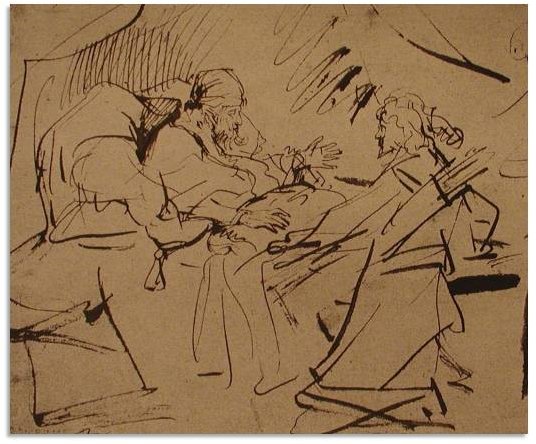
Isaac refusing to bless Esau
We can all see the great difference between Isaac and Esau. The experts must have looked at that Esau and said to themselves – Rembrandt could never have drawn that! And dismiss it. They see the awkwardness but evidently do not see the greatness of Isaac. Here is an old Jew on his deathbed refusing to bless his eldest son Esau. Old Isaac has been cheated and has given his blessing to the younger brother, Jacob. His gesture is superb – you feel the blindness, the fatalism and the extreme old age. This Isaac is Rembrandt at his very best.
Esau on the other hand is certainly expressive of shock but there is no physical substance to his body, it is cardboard. Only his head is the same caliber as Isaac. There is another drawing of Esau on the other side of the bed.
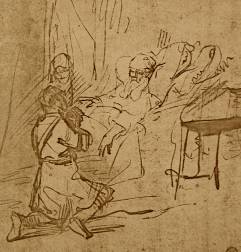
Esau on the other side of the bed
My explanation of the obvious difference in quality between these 2 figures is that Isaac is drawn from life and Rembrandt could only see Esau’s head – the body is hidden behind the bed – it is made up.
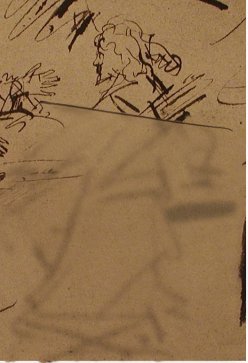
If you look carefully at his head

you will see that it has been enlarged by this line to bring it to this side of the bed – – but you can still see the smaller head Rembrandt drew first.

Here you see the two sides of Rembrandt – the brilliant observer, in Isaac and the far from brilliant inventor in Esau. If I had time I could show you this huge difference in quality between observed and invented many times. This is the basic Rembrandt characteristic that the experts fail to acknowledge.
This drawing defines the real Rembrandt perfectly but no scholar has considered it since 1922. We see the same division in the paintings. Obvious examples – the horses in The Polish Rider, or the Fredrick Rihel portrait.(Strasbourg Rider)
My version of Rembrandt is in complete agreement with what Rembrandt’s contemporaries tell us about him.
Quotes – coming soon
Modern scholarship has made up its own theories of Rembrandt’s development, without reference to the long established facts of Rembrandt’s artistic character. My discoveries have confirmed those facts. The experts want Rembrandt to be consistent – he was not – I will be showing drawings from mirror images, which have caused a more subtle decline in the quality in his work.
Unfortunately modern scholarship, over the last 100 years, has been wandering further and further from the original Rembrandt. Sadly there is no compromise position – either the experts are right and I am mistaken about him drawing from models, or, his contemporaries and I are right and recent experts are so gravely mistaken that they are no longer experts – they have swallowed the idea from their professors – that he drew from “an inner vision” and that idea has been completely invalidated. But present scholarship refuses to take note. Rembrandt is a weather-vane of feeling – not the consistent producer they wish to establish.
This could be great news for the rest of us because I see a very much larger, richer and more human Rembrandt.
Mr. Schatborn, recently of the Rijksmuseum, thinks there are only 500 drawings by Rembrandt extant today, Benesch in 1954 thought there were over 1400, I think there are over 2000.
I see Rembrandt the observer, where modern scholarship has reshaped him to conform with modern ideas about creativity; closer to the inventor, Picasso, than to the great observer known to Rembrandt’s contemporaries. We humans have a dangerous propensity to convert heroes to conform to our own contemporary tastes.
There are four good reasons why we need to take a much more generous, broad-view of Rembrandt’s production. I have shown you his variability.

He was at his best when he drew direct from nature. This is a page from my 1978 article in RembHuis kroniek.
I made this BBC film in 1976

David appointing Solomon as his successor. I regard this as top quality Rembrandt
When drawing from a reflection we must expect a lesser quality due to the poor quality of a reflection in polished metal.
Isaac and Jacob
When he drew from what we wrongly call “imagination” that is, out of his head, we must expect a bigger drop in quality. This may come as a surprise to many because of our long-standing mis-education in this respect. There are many artists similar to Rembrandt who work exclusively from observation, and maybe despise constructed drawing because it is spatially crude.
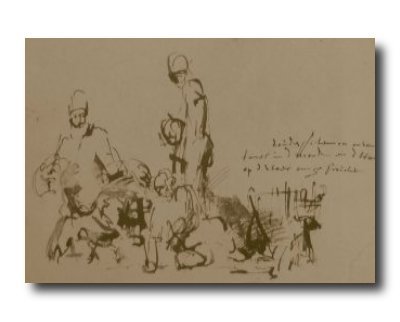
Jupiter and Baucis
We can be sure that this drawing is by Rembrandt, it has his writing on it and the writing tells the story that the drawing itself fails to tell. This is a sample of Rembrandt drawing without physical reference.
The etchings (mainly signed and dated on the plate) also show Rembrandt to be a very varied artist.
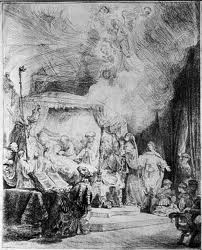
Death of the Virgin - Etching by Rembrandt
In the interest of true understanding we must not allow this natural variability to be tidied away. Rembrandt himself did not destroy his weaker works. His acceptance of failure as a normal outcome of experiment is an important aspect of his creativity. He was deeply concerned with the truth – he has shown us his weaknesses as well as his strengths: he was utterly truthful about himself and what he saw. He is therefore the most transparent artist I know. He was selling us his vision, not his craftsmanship, which could sometimes be surprisingly slipshod. (i.e. Bathsheba’s head below from the appointment of Solomon drawing above.)
***************
Rembrandt was an observer, who set up elaborate groups in his studio for himself and for his students to work from The Evidence for this is abundant. I expect to persuade this open-minded audience that there were models and a large mirror in Rembrandt’s studio in two minutes.

The great importance of the mirrors is that they prove the presence of the live models to be reflected. Here we see a group of four – acting as musicians, in fact, neither of the two real models knows how to hold their instruments (the oboist’s hands are too close to the mouthpiece, and the flautist has his instrument entirely the wrong way round) luckily he is reversed in the mirror so his reflection plays the flute correctly, note also how accurately the angle of the oboe is reflected in the fourth musician. These feathers are invented and therefore “worthless in Rembrandt’s eyes”.
Naturally Rembrandt used a mirror for his self-portraits. This example shows us that Rembrandt used a much larger mirror probably made of polished pewter or copper. Glass mirrors would have been made of many small pieces joined together. This mirror is large enough to reflect two standing men. The mirror proves this to be a studio re-creation. We should note that Rembrandt would not have gone to the trouble of producing this group if he had a photographic memory.
His inventory tells us that Rembrandt owned a large theatrical wardrobe and many props for the purpose of creating these tableaux – obviously.
The Stoning of St. Stephen.(B.959)
This example is even more telling. One could be forgiven for thinking this drawing was constructed, not observed, it seems so schematic. But even for this drawing Rembrandt posed three models in front of a large mirror. There is a right-handed stone thrower and a left-hander. This man cowering is drawn twice in reflection, St Stephen gives rise to this man reaching for a stone. Most telling, Rembrandt has even drawn in the base of the mirror – because it was there.
This use of mirrors is something that Rembrandt did nearly 100 times in drawings. See Mirrors section of www.SaveRembrandt
and once with the two paintings of “The Adoration of the Shepherds”. See Adoration section in www.SaveRembrandt.org.uk
Also see Youtube video
These paintings are of defining importance because the very size of the reflected group, the elaborate costumes and accessories of the individuals in the group, proves beyond all reasonable doubt, that what I have been saying since 1974 is correct.
The very complex interrelationship between these two paintings could not have happened by any other means, than the mirror. The London version is a reversal of a different point of view of the same 3D array of persons and objects, seen in Munich. This could not happen by chance.
Therefore Rembrandt scholars are fundamentally mistaken. We must start all over again with entirely different criteria for Rembrandt. I believe I can teach fresh minds how to set about it. My book, as yet unpublished, would be their text book.
The film of “The Adoration” on Youtube you can play over and stop the action, to compare the paintings with the photographs of the maquettes. We must not expect a perfect match. The models were human, so was Rembrandt.
In the 20 minutes available it is impossible to say ¼ of what needs to be said but I hope I have persuaded you that it is a matter of urgency that Rembrandt scholarship is revised.
In my youth Rembrandt was the great sign-post for art students. Now students no longer trust him. They do not know whether they are looking at a Rembrandt or one of his students.
This mess is a tragedy for art, a tragedy for us all, not just for Rembrandt. I have been saying this now for 36 years without effect, I need your help to bring about change in Art History.
I would be happy to instruct the young on how to set about it. I need to do this in a school of art; not of art history; because practical drawing is absolutely necessary as a basis for understanding Rembrandt’s cast of mind. He was on a journey of discovery, he did not allow the perfection of a work to slow him down. This is why his art is so transparent and instructive.
The scholars think they have mastered his handwriting, they should focus instead on his subject matter; which really interested Rembrandt. Even with the handwriting they are gravely mistaken. You will see in my DVD just how hopelessly wrong they are in the dates they assign to his drawings, let alone the re-attributions. More of the same in my published articles, more still in my as yet unpublished book on Rembrandt and on my web site and blog.
web site www.saveRembrandt.org.uk
and blog www.verrocchio.co.uk
I have prepared a small booklet and over an hour’s worth of DVD which you can study at leisure.
****************
Here we are in a hive of creativity; Together can we develop a scheme for improving the situation in art history? A foundation – PINC for the Greater Rembrandt?
This is from the booklet accompanying the enlarged DVD
(over an hours worth including Rembrandt’s Syntax)
INTRODUCTION
I published two articles proving that Rembrandt used live models and their reflections in mirrors as the subject matter for his drawings (Burlington Magazine Feb.1977
& Rembrandthuiskroniek 1978/1).
Art historians generally have a horror of mechanical aids, they cannot believe that a great master would use them; nor do they understand that many artists need reality to work from. They much prefer “imagination” as the source. My article on Rembrandt, a truly imaginative genius, (not just one who worked out of his head) deeply upset their long accepted but nonetheless mistaken ideas of the visual imagination. Rembrandt fed his imagination on reality, which he received with ever deepening empathy. His art came in two parts: first through experimenting with live tableaux of actors which he then drew with crystalline clarity. His empathy developed through the practice of these two arts together.
Art historians do not practise the arts but have diverted us, the practitioners from well tried paths to success by repeating their imagined taboos. My discovery of Rembrandt’s use of mirrors has met with stubborn resistance from the “experts”. In truth, unlike Vermeer and Velasquez, who also used mirrors, Rembrandt got no technical benefit from his use of mirrors. He seemed to use mirrors to double the number of models he had to draw from, or to vary his view of them. Often this resulted in a quality of drawing which was much inferior to his drawings drawn direct from life. (See p.2) In Rembrandt’s case the mirrors were an aid only insofar as they cut down on the number of models he needed.
You may well ask why Rembrandt used mirrors if the results were inferior? I think the answer to this question is that Rembrandt did not expect to sell his drawings, he kept them as reference – thinking they might one day inspire him. There are very few drawings that one might describe as studies for a painting or etching. It would be more accurate to call them “preliminary trials” based on groups of live models, very few of which were ever followed up. Often the exquisite drawings from life suffered the same fate of neglect as the less interesting drawings from reflection or construction. Folders of drawings were sold off at the time of Rembrandt’s bankruptcy in 1656. There are no sales of drawings recorded before then. His etchings were in great demand and were mainly signed and dated on the plate, and so are reliable testament to Rembrandt’s character and development. In fact I find no corroboration of the scholars’ ideas in the etchings; they are wildly varied with little discernible sequence in style.
When he painted the reflection of a whole group, “The Adoration of the Shepherds” (see p.1) it was to provide him with an entirely different view of the same tableau, without having to move his position, which would have upset the students also working from the same group. The large size of the mirror used in this instance, suggests it would have been made of polished metal. Glass of that size (8 foot wide) did not exist in Rembrandt’s day. Large glass mirrors were made of many smaller mirrors mounted together, which would also have resulted in an awkward image to work from. The fact that this large mirror was moved into a barn strongly favours polished metal as the material.
We have to look for a better reason for the scholars’ refusal to consider the use of mirrors, which, in view of the evidence must be obvious to the rest of us. There are two good reasons for this refusal. Firstly, it makes their hypothetical dating of the drawings according to their idea of Rembrandt’s changes of style look nonsensical. Secondly, the scholarly explanation of the variation between the master’s work and that of his students is far removed from studio reality. The iconography of Rembrandt and his school has become a scholarly industry but the variations are so much more simply and truly explained by the different physical view each student had of the same tableau. Rembrandt’s scholars are obliged to deny the presence of the model groups to avoid looking ridiculous. In avoiding ridicule they become culpable for the on-going Rembrandt catastrophe.(I am gratified to note that the RRP is closing-down in disorder. Their years of labour were largely wasted by chasing a fantasy.)
Rembrandt himself never painted from his drawings; how can the “experts” hypothesize that all his inexperienced students could do so? There is not enough information in a drawing to paint from. All the shapes and tones needed to be observed again from life. These impracticable hypotheses undermine the credibility of the experts. In addition to which their recent “findings” contradict, even reverse, all we have heard from Rembrandt’s contemporaries. “He would not attempt a single brush-stroke without a living model before his eyes…he was taught by nature and by no other law…anything else was worthless in his eyes” These beliefs are not just hyperbola, they are clearly reflected in his work as painter and etcher.
Rembrandt was the prime culture hero of my generation of art students because of these values. He was for us the exemplar of the new paradigm for art that followed very closely the new paradigm for science of his time. Like science, Rembrandt, turned his back on received wisdom (he refused to study in Italy) and studied nature directly and with an improved syntax. (see DVD) He is therefore more relevant to us today than the older masters.
It is difficult to believe that the civilized world has continued to have faith in a group of experts whose every word and action contradicts all previous judgements, let alone my concrete evidence for a much more liberal view of Rembrandt output. My evidence has been deduced from careful observation of Rembrandt’s drawings; furthermore, my findings are in agreement with the characteristics recorded by Rembrandt’s contemporaries and the signed etchings.
**************
The Sack of Rome was perpetrated in three or four days by pillaging soldiery who we do not expect to have a great understanding of the arts. By contrast the recent destruction of Rembrandt, which posterity (and many of the living) may judge to be more far-reaching in effect, was carried out by museum experts over a period of 80-100 years. The destruction of Rembrandt has been given full media coverage but apparently never caused a murmur of complaint from their colleagues. On the contrary it has been endorsed by major exhibitions and expensive publications.
If any good is to be hoped for from the Rembrandt catastrophe it should precipitate a full scale overhaul of the way we arrive at cultural decisions. I would suggest putting artists back in charge. At least this would ensure a wide ranging and heated debate, something that the present regimes of art historians avoid. My experience shows art historians effectively squashing the opposition by their refusal to debate. This coupled with the subsidized power and prestige of their exhibitions and publications has made their flawed position apparently impregnable.
My Museum of Artists Secrets consists of important similar examples and criticisms of of the way the history of art is handled at present. Art history, which affects us all, has become the exclusive domain of experts without the necessary practical background or aesthetic sensibility.
The experts have made pathetic attempts to deny this mass of evidence, most notably in The British Museum catalogue of 1992 “Drawings by Rembrandt and his Circle”. They wish us to continue to believe that Rembrandt drew from imagination, not from tableaux vivants. Since my articles in 1977& 1978 they have got away with it. My single voice, though it has been backed by many eminent art historians including Prof. Sir Ernst Gombrich, is insufficient to stir them to reaction or discussion.
More of the same www.saveRembrandt.org.uk
Konstam’s blog www.verrocchio.co.uk
WE NEED YOUR HELP TO PERSUADE THE SCHOLARS TO CHANGE.
PLEASE VOTE ON THE WEBSITES ABOVE
Nigel Konstam, for The Save Rembrandt Society 2011
I have been silent for quite a time because I have been busy preparing a talk for PINC conferences. It has been very demanding trying to put all that is necessary to see the greater Rembrandt, into 20 minutes for a lay audience. Some may not even know that Rembrandt’s work has been cut by more than half in the last 40 years by the experts. I think I have pulled it off.
I will be delivering the talk in the PINC series on May 17th. I will publish it on this blog soon afterwards. It is most gratifying that the Rembrandt Research Project has collapsed before finishing their labours; people may at last be ready to listen to my lone, dissenting voice.
Info @ PINC.nl